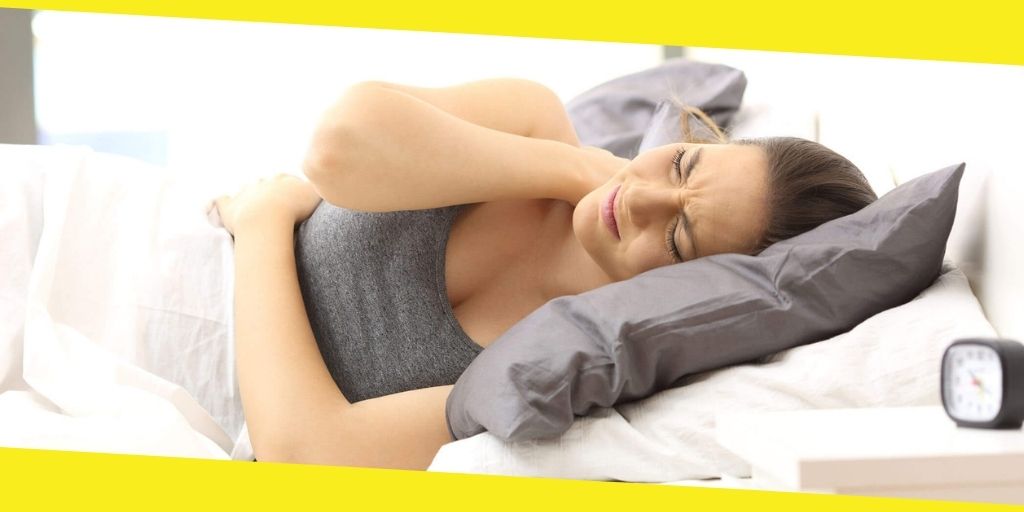Musculoskeletal Issues of Getting a Good Night’s Sleep
This post was last updated on November 22nd, 2022

I am quite confident that most if not all adults have experienced a poor night’s sleep. Unfortunately, many adults experience far too many nights tossing and turning desperately trying to either fall asleep or fall back asleep after awakening. Of course, there can be myriad reasons why a person can struggle with getting the sleep they need to function properly the next day, let alone sleep depravation’s impact on health and disease risk. Reasons for failing to obtain inadequate sleep can range from emotional stressors a person is experiencing at a time in their life, medicines they may be taking, poor bed or pillow quality, to a number of health issues with which they may be fighting to overcome or endure.
From a musculoskeletal standpoint, there are certain sleeping positions that can put abnormal or out of balance strain on your back or other body parts and not only disrupt sleep but lead to chronic pain and postural issues.
If this issue affects your sleep, an osteopath Croydon or your area may help you find the solutions you need.
Your Primary Sleeping Position and Your Spine
You simply cannot say to a person that they “must” sleep on their back or on their side or in the fetal position to sleep correctly. We have different body types, varying skeletal configurations in the pelvis, neck, back, and legs as well as other anatomical differences.
No two people will have the same ideal shape. This is key to determining how you should configure yourself for maximum comfort and ease of sleep.
These differences can impact sleeping position for comfort and musculoskeletal health. Consider these:
Wide hips
Those with wider hips tend to sleep better, from a musculoskeletal standpoint, on a softer mattress, especially if they are a side-sleeper. The softer feature allows for the pelvis to sink a little deeper into the mattress and thus reduce the torque applied to the lumbar spine. A healthy spine is straight when viewed from the back, and any significant lateral bending increases the stress applied to the lumbar spinal segments, potentially adversely affecting muscle, connective tissue, vertebral discs, and vertebral facets.
The side sleeper
If you sleep on your side, whether or not you have wide hips, you will have some degree of torque at the lumbar spine area. The reason being is that the lengthy femur bone of the upper leg will slant downward causing the pelvis to rotate laterally and produce a curve in the lumbar spine as it “goes along for the ride” and bends slightly laterally. To help reduce or eliminate the torque, place a pillow between your legs. This occupies the space between the two femur bones helping ensure normal alignment of the pelvis and consequently the lumbar spine that arises from the pelvis. It should be noted that by flexing the hip and knees into a so-called fetal position, this naturally helps reduce the amount of torque that is applied and is a beneficial adjustment.
In addition to placing a pillow between your legs, side sleepers also need a pillow that will maintain the normal healthy spinal alignment at the neck. If the pillow is too thin it will not be able to sufficiently “occupy the space” between your downside shoulder and your head. This will cause a lateral and downward curve of the cervical (neck) spine and place undesirable stresses on neck anatomy. If the pillow is too thick and firm it will cause a lateral and upward curve in the neck and the associated stresses on those tissues.
Sleeping on your side is also recommended for pregnant women, people with acid reflux, people with severe back pain, heavy snorers, or those who have sleep apnea. Even older adults get to sleep easier with this position. And if you do sleep on your side, it would be best to sleep more on your left side than on the right. It’s been found that sleeping on your right side increases the pressure on your internal organs and may increase the occurrence of heartburn.
An appropriate fitting pillow will ensure that the head and neck stay in alignment with the lower spinal segments (thoracic and lumbar) and eliminate or reduce lateral spinal bending. NOTE: It should be stated that it is recommended to switch the side on which you sleep every few sleeping episodes giving other muscles the responsibility for support function while sleeping. Of course, this may be easier said than done as we most likely have a side preference, as well as the fact that we tend to be creatures of habit.
The back sleeper
If you sleep on your back, placing a pillow under your knees will help maintain the normal lordotic curve of your lower back. Without a pillow being placed under the knees, the lordotic curve will be exaggerated in the back lying position, especially on a firm mattress. Without a pillow under your knees the weight of your legs and the downward force of gravity will cause an exaggerated curve in the lumbar spine of your back and stress the intervertebral discs, vertebral facets, and other soft tissue structures on the concave side of the spinal curve. A consistent and long-term exaggerated lumbar curve (at sleep as well as when standing or sitting) can also increase the risk of incurring a disc herniation in the future.
People who have nasal congestion also benefit from sleeping in this position. It relieves congestion and helps them breathe clearly, which, in turn, makes sleeping easier. Those who practice a skincare routine should also note that this position helps reduce wrinkles by keeping pressure away from the face.
In addition to placing a pillow under your knees, back sleepers need appropriate support for the cervical (neck) spine. Of course, this is the function of a pillow which should be of sufficient thickness to support and allow the normal neck curvature to exist while sleeping. If the pillow is too thick, it forces the neck into flexion and puts considerable stress on the posterior neck vertebrae and surrounding soft tissues. As with previously mentioned undesirable body positions, not maintaining the normal biomechanics of the spine places unbalanced stresses on neck tissues and can contribute to irritation and inflammation of those tissues, and pain is the result.
The front/belly or prone sleeper
Sleeping on your belly places forces on your lumbar spine and is often associated with lower back pain. Yes, some people sleep this way and seem to arise in the morning with no ill effects. Mostly this applies to young people. However, sleeping in this abdominal down position still increases the lordotic curve and puts undesirable pressure on the low back structures. Working to change from this position is recommended whether you have low back problems and are pain free, as in time the effects of tissue strain will take a toll and the symptoms will appear.
There’s a reason why this is the least preferred sleeping position. To sleep comfortably in it, your neck must be tilted to the side. This puts it out of alignment with your spine.
If the mattress is not firm enough, it might cause you to sink into it, making your spine stretch uncomfortably. This is a recipe for back pain.
Additionally, women with ample bosoms might want to avoid sleeping this way. It compresses breast tissue and cramps blood flow, leading to discomfort.
What About Other Musculoskeletal Issues That Can Affect Sleep and Musculoskeletal Health?
If you have a shoulder problem such as shoulder impingement or rotator cuff tendinitis, sleeping on your side can exacerbate (or contribute to its occurrence) the condition by placing the shoulders in a forward and rounder position. The downside shoulder has ground reaction forces that force that shoulder into a forward and rounded position, while the upside shoulder/arm has gravitational forces causing it to slump downward into the rounded position.
As previously stated, it may not be feasible to have a person stop sleeping on their side, a position that can be unconsciously assumed when sound asleep. Therefore, incorporating a few adjustments and a specific shoulder exercise upon rising in the morning (as well as various times throughout the day) can help to ease the tension side-lying places on the shoulders.
Adjustment #1
Place a pillow in front of you so that the upside arm will have something to rest upon, eliminating the effect of gravity to force it downward and forward.
Adjustment #2
Instead of placing your downside arm tucked next to our body, which is an internally rotated position (this compounds the stress), place it up so that with a flexed elbow your hand is under your pillow and under your head. This is a shoulder externally rotated position and less stressful to the shoulder joint structures.
Shoulder Exercise
Grasping an elastic exercise band with both hands spread 4 to 6 inches apart and palms down, pull hands apart while you move your arms out in front and continue upward until both arms are raised fully above your head and the exercise band is pulled apart to full tension.
One Final Musculoskeletal Related Recommendation
One final recommendation for good sleep from a musculoskeletal standpoint is to get regular exercise, especially muscle strength through resistance training and range of motion through stretching exercises. Muscles and connective tissues that are strong and flexible are better able to withstand greater stresses that may be placed on them without succumbing to irritation or injury. A fit body sleeps better than an unfit body.
A Few Other Considerations – Your Mattress and Pillow
A general recommendation that of course comes with some real variability (quality of mattress, size of individuals, etc.) is to get a new mattress at least every 7 years. Like any material, they too break down over time and needs to be replaced to provide the support needed for quality sleep. Likewise, it is recommended to replace your pillow every year as it compresses over time and loses its ability to properly support the neck.
Lynn Perkes is a full-time faculty member at Brigham Young University-Idaho teaching courses in Kinesiology and Biomechanics, Applied Kinesiology and Assessment, Therapeutic Exercise, and Physical Therapist Assistant classes. He writes part-time for ProhealthcareProducts.com, who sells healthcare, therapy, fitness, and personal protective equipment products.
Recommended For You
9 Health Risks Of Sedentary Lifestyle You Must Know
Most Inside
Most Inside offers high-quality recommendations and valuable updates to enhance all aspects of your life, providing premium guidance and enriching experiences.




